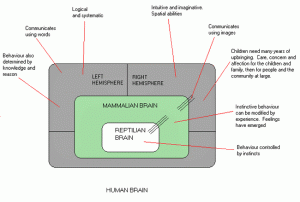 In John Nosta’sThinkology blog post, “The Fundamental Marketing Dilemma: Language is a Lie,” he discusses books like Malcom Gladwell’sBlink and Tor Norretranders’s The User Illusion, which explore the ideas of how we perceive things. These authors assert that our first impressions are processed not by conscious thought and language, but by much faster processes that are rooted in our reptilian and mammalian brains.
In John Nosta’sThinkology blog post, “The Fundamental Marketing Dilemma: Language is a Lie,” he discusses books like Malcom Gladwell’sBlink and Tor Norretranders’s The User Illusion, which explore the ideas of how we perceive things. These authors assert that our first impressions are processed not by conscious thought and language, but by much faster processes that are rooted in our reptilian and mammalian brains.
Nosta’s take is that language is really “a corrupted surrogate for what’s REALLY happening.” He says that maybe we shouldn’t be asking our customers what they’re thinking. Maybe we would get more and/or better information by trying to measure direct neural function such as eye tracking, facial coding and other biometrics.
What about surveys and focus groups? Bunk! According to Nosta, people’s thought processes pollute their first impressions about a product or service to the point that the language expression we get in response to asking a question isn’t reliable—and yet 90% of market research focuses on verbal communication, while verbal accounts for only 23% of most communication.
So what’s a marketer to do?
Now while I didn’t really like Blink, and still think Gladwell, no matter how brilliant, was just cashing in on the success of Tipping Point, I get the whole “first impression” thing and how it can shape your interactions going forward. In fact, I think that’s why images are so very important, and why a site like Pinterest is taking the social media world by storm, and why Facebook paid a cool $1Billion for Instagram.
This power of visual medium is much more evident in social, where reaction is faster (and often more visceral) than in traditional marketing. That’s the reason more people hit the “like” button than actually take the time to comment or even share a post. It can be done in that “blink” period—rather than taking the time to process through language centers.
Think about it. Why is YouTube the second largest search engine? Why do people react more on Facebook to images and videos than any other type of post? It’s pretty simple… we connect more in the “blink” of an eye to what we see rather than what we read. It stays with us longer and allows us to process in so many ways. That is also why creating short memes or one-liners of 140 characters or less (yes Tweets) can be so powerful… easy for people to process, remember, and share.
So as a marketer, how can you turn that to your advantage? What visual or auditory tools could you use to get people to connect and react on a subconscious level—rather than the need for them to “process” first and then take an action? I find this fascinating and think there is so much opportunity for this in in the social realm.
A lot of companies are springing up in the “Neuromarketing” field that use biometric tools to help businesses get a better sense of how people react to advertisements and other marketing stimulus (before language kicks in). However, I think you could get started in the right direction by reading books like Roger Dooley’s Brainfluence to get a better handle on it.
In the meantime, and within the petri dish we all have at our fingertips, experiment with various ways to use images, video and short one-liners in your social communications. Pay attention and see how people respond. Do they get more interaction than standard posts? What kind of interaction? Do you see any patterns over time? Start using Pinterest, Instagram and any other visual tools your consumers fancy… and try all different things.
Visual is powerful and how consumers relate to, share, and think about what they have seen can open a whole new world to marketers… but it ‘s scary and hard to control. Are you ready?
Originally posted at TedRubin.com